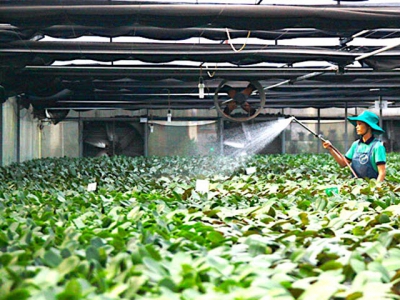Hanoi strives to have all communes meeting new-style rural area standards in June

The city will this year promote the implementation of the national program on new-style rural areas and agricultural restructuring for better living standards of people in rural areas for the period 2021-25.
100% of Hanoi’s communes meet new-style rural area standards this June. Photo: Lam Nguyen
Hanoi strives for 100% of its rural communes to meet standards for new-style areas by June this year, according to the Hanoi Office of New Rural Development Program Coordination.
The standards include 19 criteria on different aspects such as infrastructure, irrigation, electricity, environment, income, education, healthcare, social security and culture, among these, nine criteria are used to assess district's annual performance.
Currently, there are seven new-style rural districts in the city, including Dan Phuong, Dong Anh, Thanh Tri, Hoai Duc, Quoc Lai, Gia Lam and Son Tay town; 367 out of its 382 communes achieved all the criteria with 18 of them being recognized as advanced new-style rural areas.
According to the Hanoi Office of New Rural Development Program Coordination, in 2021, the city will roll out Program No.4 on promoting the implementation of the national program on new-style rural areas and agricultural restructuring for better living standards of people in rural areas for the period 2021-2025.
Besides, the Office will also propose to the government, through the Ministry of Agriculture & Rural Development, to recognize three districts including Me Linh, Chuong My and Ung Hoa as the new-style rural areas. It continues assessing and evaluating more communes with criteria of new-style rural, advanced rural and model rural areas.
Có thể bạn quan tâm
 RCEP helps Vietnamese agricultural products reach out to the world
RCEP helps Vietnamese agricultural products reach out to the world The mammoth trade deal Regional Comprehensive Economic Partnership (RCEP) is expected to unlock more export markets for Vietnamese agricultural products
 Total of 205 traders allowed to export rice
Total of 205 traders allowed to export rice Up to 205 local traders nationwide were permitted to export rice as of January 18, following a list released by the Ministry of Industry and Trade’s Import
 Needed - A proper strategy to attract FDI in agriculture
Needed - A proper strategy to attract FDI in agriculture Foreign direct investment (FDI) in the agricultural sector remains modest, accounting for just 1.61 percent of the total number of FDI projects and 0.97 percent